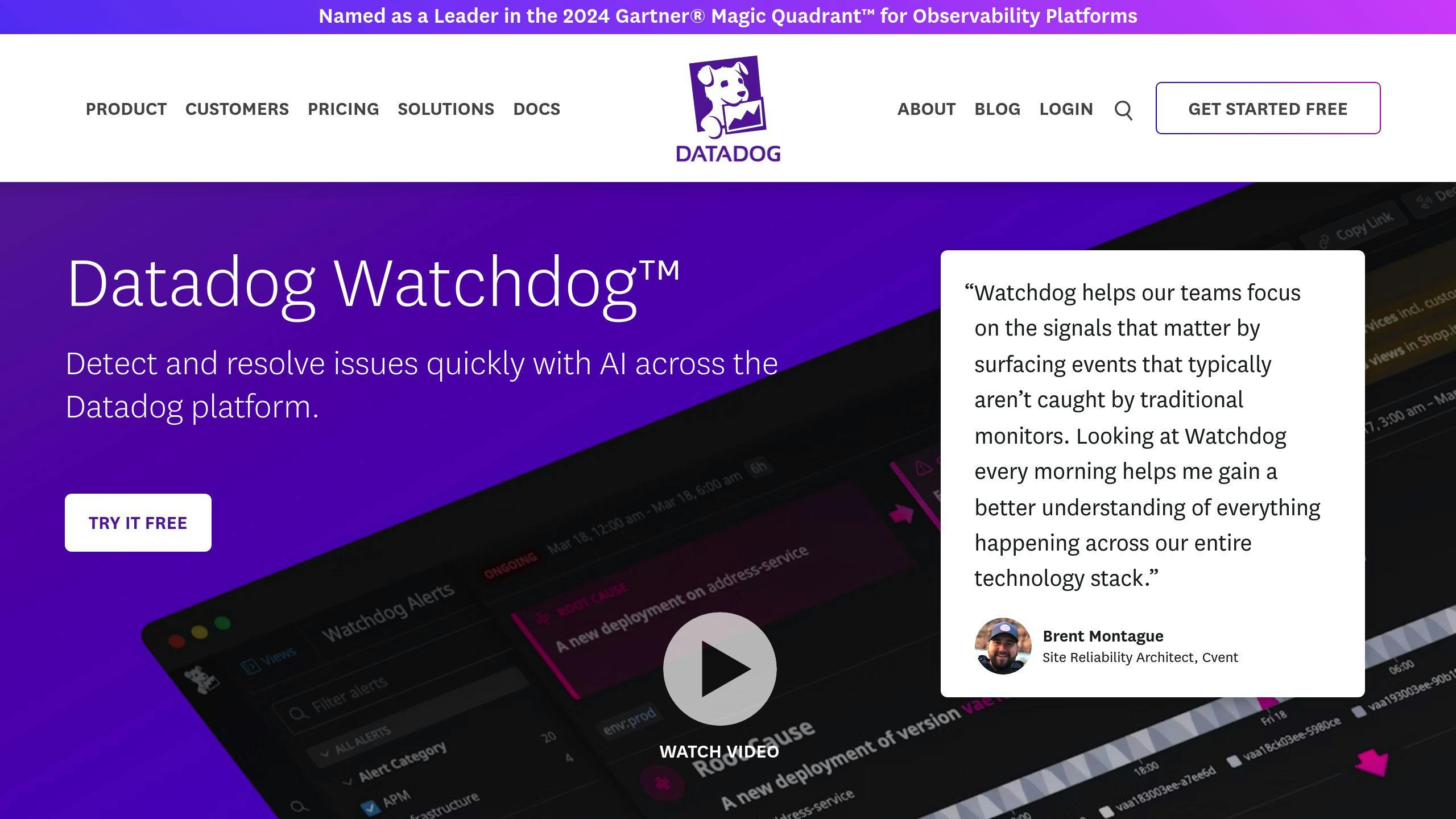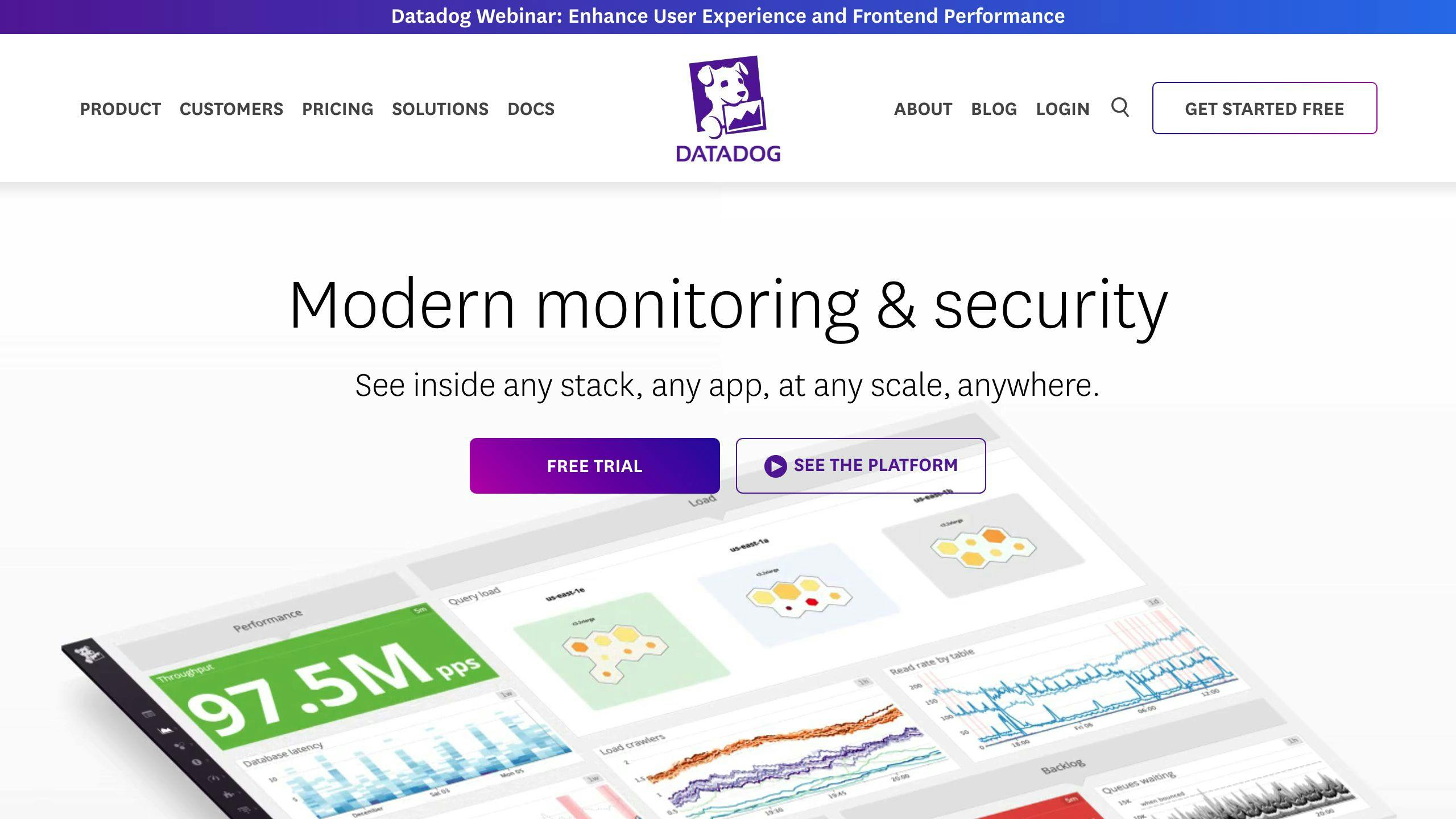Datadog Watchdog and Eyer.ai are AI-powered monitoring tools for IT operations. Here's a quick comparison:
| Feature | Datadog Watchdog | Eyer.ai |
|---|---|---|
| Company size | Large enterprises | Small to medium businesses |
| AI focus | Assists monitoring | Drives monitoring |
| Integrations | 750+ | Limited |
| Pricing | Higher | Lower |
| User experience | More complex | Simpler |
| Anomaly detection | Reactive | Proactive |
| Root cause analysis | Connects issues | Quick explanations |
| Best for | Cloud-native, DevOps | AI-focused teams |
Datadog Watchdog is ideal for big companies with complex setups and dedicated DevOps teams. It offers extensive integrations but comes with a steeper learning curve and higher price tag.
Eyer.ai suits smaller companies wanting AI to handle most of the monitoring work. It's more budget-friendly and easier to use, but has fewer integrations and a smaller user community.
Both tools aim to cut manual work and speed up problem-solving in IT operations. Your choice depends on your company size, budget, and how much you want AI to drive your monitoring process.
Related video from YouTube
About Datadog Watchdog

Datadog Watchdog is an AI-powered monitoring tool that spots issues in your infrastructure and apps automatically. It's part of Datadog's bigger observability platform.
Datadog, the company behind Watchdog, has been around since 2010. They're public now, trading on NASDAQ as DDOG. They launched Watchdog in 2018, adding machine learning smarts to their toolkit.
Here's what Watchdog does:
- Finds weird patterns in your system on its own
- Figures out what's causing problems across services
- Keeps an eye on things like latency spikes and error rates
- Sends heads-up when it spots issues
Watchdog works like this:
- Watches your infrastructure and app metrics non-stop
- Uses AI to figure out what's "normal"
- Spots anything that's not normal
- Creates "stories" about weird stuff it finds, in plain English
- Gives you detailed stats on affected services
It's built for IT and DevOps folks managing complex cloud setups. SREs use it to check system health quickly. DevOps teams use it to fix problems faster. IT managers use it to decide what to fix first.
"Checking Watchdog every morning helps me understand what's happening across our whole tech stack." - Brent Montague, Site Reliability Architect at Cvent
Watchdog plays nice with big cloud services like AWS, Azure, and Google Cloud. That's why it's popular with businesses using multiple clouds or hybrid setups.
2. About Eyer.ai

Eyer.ai is the new kid on the block in AI-powered monitoring. Born in 2020, this startup is all about shaking things up.
Unlike the big players, Eyer.ai is laser-focused on AI-driven monitoring. No frills, no distractions - just smart, efficient system watching.
What's in Eyer.ai's toolbox?
- Predicts problems before they happen
- Turns tech-speak into plain English
- Finds the root cause of issues, fast
- Adjusts alerts based on what's normal for your system
- Plays nice with cloud and on-site setups
Who's it for?
Eyer.ai isn't trying to be everything to everyone. They're after:
- Startups and smaller businesses looking for big-league monitoring without the big-league price tag
- DevOps teams who want to squash issues quicker
- Companies knee-deep in AI and machine learning
Eyer.ai might not have Datadog Watchdog's massive client list (yet), but it's turning heads. Tech-savvy folks are loving its fresh take on monitoring - powerful, but without the headache.
3. Comparing monitoring features
Let's see how Datadog Watchdog and Eyer.ai stack up in system monitoring.
3.1 Detecting anomalies
Datadog Watchdog and Eyer.ai use AI differently:
- Datadog Watchdog spots metric spikes and drops automatically. It's your smart system assistant.
- Eyer.ai predicts issues before they happen. It's proactive, not just reactive.
3.2 Managing alerts
Both tools fight alert fatigue:
- Datadog Watchdog sends context-rich alerts. You get the full picture, not just "something's wrong."
- Eyer.ai adapts alerts to your system's normal. Fewer false alarms mean more rest for your team.
3.3 Finding root causes
When things go south, you need answers fast:
- Datadog Watchdog connects the dots between issues. It's your system detective.
- Eyer.ai promises quick, jargon-free root cause explanations.
3.4 Showing performance data
Both make data digestible:
- Datadog Watchdog offers custom dashboards. You see what you need.
- Eyer.ai keeps it simple with clear system health views.
3.5 Working with other tools
Integration matters:
- Datadog Watchdog boasts 750+ integrations. It's a monitoring Swiss Army knife.
- Eyer.ai, though newer, works with cloud and on-site setups. It's built for modern tech stacks.
4. AI and machine learning tools
Datadog Watchdog and Eyer.ai use AI to supercharge their monitoring. Let's compare them.
4.1 AI models used
Datadog Watchdog's AI toolkit:
- Spots weird metric patterns
- Predicts future trends
- Finds outliers in data
- Links related metrics automatically
Eyer.ai's AI arsenal:
- Sees potential issues coming
- Quickly finds problem sources
4.2 Learning from new data
These tools get smarter over time, but differently:
Datadog Watchdog:
- Uses past data to spot anomalies better
- Updates forecasts based on recent trends
Eyer.ai:
- Learns what's "normal" for your system
- Sharpens predictions with each new data point
4.3 Predicting future issues
Datadog Watchdog:
- Forecasts resource use (like disk space)
- Warns teams about problems a week early
Eyer.ai:
- Tries to prevent issues before they happen
- Aims to spot trouble before it hits performance
The big difference? Watchdog mostly reacts to current data. Eyer.ai tries to stay one step ahead.
| Feature | Datadog Watchdog | Eyer.ai |
|---|---|---|
| Focus | Real-time monitoring | Predictive analysis |
| Learning | Improves existing models | Adapts to your system |
| Prediction | Resource forecasting | Issue prevention |
Both tools cut manual work and speed up problem-solving. For example, Datadog's Bits AI helps create tests from simple prompts, saving DevOps teams time.
"The element of intelligence is what sets AIOps platforms apart. And it's this critical ingredient that gives AIOps its value within the modern-day workplace." - David Lithicum, GigaOm Analyst
This quote nails why AI matters in monitoring. It's not just about data collection—it's about making sense of it FAST.
5. Handling large systems
Datadog Watchdog and Eyer.ai both tackle big IT networks, but they do it differently. Let's compare:
5.1 Managing big IT networks
Datadog Watchdog:
- Uses AI to find issues automatically
- Spots problems in microservices and cloud setups
- Creates "stories" about detected issues
Eyer.ai:
- Likely combines data from various IT sources
- Probably helps find root causes in complex setups
5.2 Processing speed
Datadog Watchdog:
- Built for quick problem-solving
- Constantly analyzes data
- Aims to catch issues early
Eyer.ai:
- Speed details aren't clear
- Likely fast to compete with Datadog
5.3 Cloud and on-site options
| Feature | Datadog Watchdog | Eyer.ai |
|---|---|---|
| Cloud support | Yes | Probably |
| On-premises | Yes | Unknown |
| Hybrid setup | Yes | Unknown |
Datadog works with cloud, on-site, and hybrid setups. It connects to over 700 tools.
Eyer.ai's options aren't specified.
"Our CMDB helps correlate incidents and to isolate circuits and devices that are down by doing lookups on alerts to see what has been affected. We have automation that automatically attaches the CIs." - Lindsey Logsdon, Platform Integration Specialist, INOC
This quote shows how these tools can link alerts to specific IT parts, helping manage large systems.
For big companies, these tools can save time and catch problems fast. But your choice depends on what you need.
sbb-itb-9890dba
6. User experience
Datadog Watchdog makes monitoring a breeze. Here's what you need to know:
6.1 Setup process
Getting started with Datadog Watchdog? It's as easy as 1-2-3:
- Sign up for Datadog
- Install the Agent
- Start monitoring
Developers, rejoice! Datadog offers APIs in Python, Ruby, and Go for flexible setup options.
6.2 Customizing dashboards
Datadog's dashboard customization is where it really shines:
- Drag-and-drop builder
- Tons of visualization options
- Ready-made dashboards to get you going
Want to tweak an existing dashboard? Just clone it and make it your own. Easy peasy.
| Customization | What You Get |
|---|---|
| Visuals | Graphs, heatmaps, tables |
| Data | Metrics, logs, traces |
| Layout | Drag-and-drop, resizable widgets |
| Sharing | Public URLs for external viewing |
6.3 Creating reports
Datadog's got your back when it comes to performance reports:
- Real-time data connections
- Mobile app for on-the-go access
- API endpoints for report automation
Keep your dashboards tidy:
- Use custom lists for quick searches
- Add descriptions to dashboards
- Regularly clean house
"Our CMDB helps correlate incidents and to isolate circuits and devices that are down by doing lookups on alerts to see what has been affected. We have automation that automatically attaches the CIs." - Lindsey Logsdon, Platform Integration Specialist, INOC
This quote shows how Datadog's tools can help manage complex systems and create useful reports.
Datadog Watchdog offers a user-friendly experience with plenty of customization options. We don't have info on Eyer.ai's user experience to compare, though.
7. Pricing
Let's talk money. How do Datadog Watchdog and Eyer.ai compare cost-wise?
7.1 Cost comparison
Datadog's pricing is usage-based. Here's a quick look:
| Service | Price |
|---|---|
| Infrastructure Pro | $15 per host/month |
| APM | $31 per host/month |
| Container Monitoring | $1 per container/month |
| Real User Monitoring | $1.50 per 1k sessions/month |
We don't have Eyer.ai's pricing info. So, let's focus on what we know about Datadog.
7.2 Free trials
Datadog offers:
- 14-day free trial (Pro plan)
- No credit card required
- Full feature access
It's like test-driving a car before buying.
7.3 Business packages
For larger operations, Datadog has:
- Infrastructure Enterprise: $23 per host/month
- Infrastructure DevSecOps Enterprise: $34 per host/month
These come with extra features for big-scale ops.
But here's the thing: Datadog's costs can add up. One user said:
"Datadog is expensive."
The takeaway? Datadog's pricing is flexible, but plan carefully. You might face a big bill if you're not watching your usage.
Note: We lack Eyer.ai's pricing details. For a fair comparison, you'll need to research their costs separately.
8. Support and guides
Let's compare how Datadog Watchdog and Eyer.ai handle support and documentation.
8.1 Getting help
Both platforms offer support, but Datadog Watchdog has more options:
| Support Channel | Datadog Watchdog | Eyer.ai |
|---|---|---|
| Email support | Yes | Yes |
| Live chat | Yes | No |
| Phone support | Enterprise only | No |
| Knowledge base | Yes | Yes |
Datadog's got the edge here, especially for big companies.
8.2 User guides
Datadog's docs are comprehensive. They've got:
- Detailed tutorials
- API references
- Best practices
Eyer.ai keeps it simple with:
- Setup instructions
- Core feature explanations
Datadog's guides are more thorough and frequently updated.
8.3 User communities
Datadog boasts a thriving community:
- 50,000+ member forum
- Regular webinars
- Annual Dash conference
Eyer.ai's community is smaller:
- GitHub discussions
- Invite-only Slack channel
Datadog's larger community means more shared knowledge and peer support.
Bottom line? Datadog offers more robust support and resources. But if you prefer a no-frills approach to getting help, Eyer.ai might be your speed.
9. Pros and cons
Let's compare Datadog Watchdog and Eyer.ai:
| Datadog Watchdog | Eyer.ai |
|---|---|
| Pros: | Pros: |
| • Popular with cloud startups | • AI-powered monitoring |
| • Customizable UI | • Quick data analysis |
| • Easy setup | • Automated event detection |
| • Many integrations | • Personalized assessments |
| • Good support | • Budget-friendly |
| Cons: | Cons: |
| • Tricky log management | • Smaller community |
| • Pricey for big companies | • Limited support |
| • Hard to learn | • Possible AI bias |
| • UI can confuse newbies | • May not fit all cases |
Datadog Watchdog is flexible and integrates well. As Anuj Rai from DISYS says:
"Datadog was our go-to for monitoring everything - apps, databases, servers, you name it."
But watch out - as you grow, costs can jump. Many startups find they can't keep logs as long, making it tough to solve complex issues.
Eyer.ai uses AI to spot problems fast and tailor your monitoring. It's quick and can save you money. The downside? Fewer users mean less community help, and AI isn't perfect - it can be biased or miss the mark sometimes.
Your choice depends on what you need, what you can spend, and how you feel about AI. Both tools have their strong points, so think about what matters most to you.
10. Best uses
Datadog Watchdog and Eyer.ai cater to different business needs. Here's a breakdown:
Datadog Watchdog:
- Cloud-native startups
- DevOps-driven organizations
- Companies with complex, distributed systems
Airbnb, with its complex setup, uses Datadog. They monitor 40,000+ hosts and process 2 million metrics per second.
Eyer.ai:
- Small to medium-sized businesses (SMBs)
- AI-focused teams
- Companies needing fast data analysis
Eyer.ai's newer market presence means fewer specific examples, but its AI-driven approach appeals to companies wanting automated monitoring.
Choosing between the two:
| Factor | Datadog if... | Eyer.ai if... |
|---|---|---|
| Company size | Large enterprise | SMB |
| Budget | Can afford higher costs | Need cost-effective solution |
| Integration needs | Extensive third-party integrations | AI-driven insights priority |
| Monitoring focus | Infrastructure and application | AI-powered event detection |
| Team expertise | Dedicated DevOps team | Simpler, automated approach |
11. Conclusion
Datadog Watchdog and Eyer.ai both have their sweet spots. Let's break it down:
Datadog Watchdog is your go-to for:
- Big companies with complex systems
- DevOps teams needing lots of integrations
- Those ready to invest in a full-scale monitoring solution
Eyer.ai fits better for:
- Smaller companies watching their budget
- Teams wanting AI to do the heavy lifting
- Folks who like things simple and ready-to-go
Choosing between them? Here's a quick comparison:
| Factor | Datadog Watchdog | Eyer.ai |
|---|---|---|
| Company size | Big | Small to medium |
| Price tag | Higher | Lower |
| Plays well with others | Tons of options | Fewer, AI-focused |
| Learning curve | Steeper | Gentler |
| AI smarts | Assists you | Drives the show |
Datadog's strength? It's a Swiss Army knife for monitoring. As one tech pro put it:
"Datadog turns the flood of data from your apps and tools into actionable insights."
It's why companies like Airbnb use it to keep tabs on 40,000+ hosts and crunch 2 million metrics every second.
Eyer.ai, on the other hand, is for those who want AI to do the heavy lifting without a big DevOps team.
Pro tip: Try before you buy. Both offer free trials. And as one Datadog user said, run a test drive before going all-in.
FAQs
What is a watchdog monitoring system?
A watchdog monitoring system is like a digital guard dog for your tech. It keeps an eye on your IT setup, spotting important signals in your data to help find and fix problems fast.
What are some Datadog alternatives?

While Datadog is popular, other options might suit you better:
| Alternative | Strong Points | Best For |
|---|---|---|
| AppDynamics | Full-stack observability, APM focus | Large enterprises |
| SigNoz | Open-source, on-premise option | Budget-conscious teams |
| New Relic | User experience monitoring | Customer-centric apps |
Try a few to see which one clicks with your team.
Does Datadog use AI?
Yes, it does. Datadog's platform includes over 750 integrations that use AI for monitoring. This helps teams keep tabs on AI-heavy setups, from infrastructure to models.
What's Watchdog AI?
Watchdog AI is Datadog's built-in AI engine. It scans your system data and:
- Sends smart alerts
- Offers insights
- Finds root causes of issues
The best part? It works right out of the box - no setup needed.



